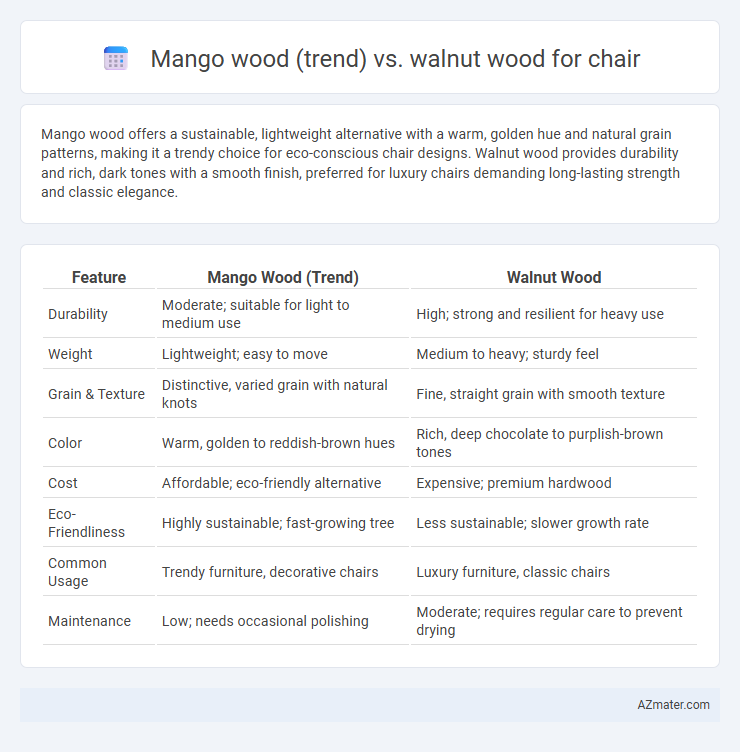Mango wood offers a sustainable, lightweight alternative with a warm, golden hue and natural grain patterns, making it a trendy choice for eco-conscious chair designs. Walnut wood provides durability and rich, dark tones with a smooth finish, preferred for luxury chairs demanding long-lasting strength and classic elegance.
Table of Comparison
| Feature | Mango Wood (Trend) | Walnut Wood |
|---|---|---|
| Durability | Moderate; suitable for light to medium use | High; strong and resilient for heavy use |
| Weight | Lightweight; easy to move | Medium to heavy; sturdy feel |
| Grain & Texture | Distinctive, varied grain with natural knots | Fine, straight grain with smooth texture |
| Color | Warm, golden to reddish-brown hues | Rich, deep chocolate to purplish-brown tones |
| Cost | Affordable; eco-friendly alternative | Expensive; premium hardwood |
| Eco-Friendliness | Highly sustainable; fast-growing tree | Less sustainable; slower growth rate |
| Common Usage | Trendy furniture, decorative chairs | Luxury furniture, classic chairs |
| Maintenance | Low; needs occasional polishing | Moderate; requires regular care to prevent drying |
Introduction to Mango Wood and Walnut Wood Chairs
Mango wood chairs showcase a contemporary trend in furniture design, prized for their sustainability and unique grain patterns that offer a warm, rustic appeal. Walnut wood chairs remain a classic choice, valued for their rich, deep brown hues and exceptional durability, making them a timeless investment. Both woods provide sturdy construction, but mango wood stands out for eco-friendliness, while walnut is renowned for its luxurious finish and longevity.
Popularity Trends: Mango Wood vs Walnut Wood
Mango wood has surged in popularity for chair manufacturing due to its sustainable sourcing and unique grain patterns, offering an eco-friendly alternative to traditional hardwoods. Walnut wood remains a classic choice, favored for its rich color, durability, and high-end appeal, consistently ranking high in premium furniture markets. Recent market data indicates mango wood chairs are gaining traction among millennials and eco-conscious consumers, while walnut chairs maintain strong demand in luxury and traditional furniture segments.
Aesthetic Differences Between Mango and Walnut Wood
Mango wood features a lighter, golden-brown hue with distinct grain patterns that often include natural knots, creating a rustic and warm aesthetic ideal for casual or bohemian-style chairs. Walnut wood exhibits a rich, dark brown color with smooth, straight grains and occasional wavy patterns that lend a sophisticated, elegant, and timeless appeal, perfect for formal or modern furniture designs. The contrasting color depth and grain intricacy between mango and walnut wood significantly influence the visual impact and style direction of chair designs.
Durability and Strength Comparison
Mango wood offers moderate durability and strength, making it suitable for lightweight chair designs that prioritize eco-friendliness and affordability. Walnut wood surpasses mango wood in hardness and resistance to wear, providing superior durability and structural integrity for high-end, long-lasting furniture. Choosing walnut ensures a robust chair with excellent load-bearing capacity, while mango wood suits decorative pieces where cost-effectiveness is key.
Sustainability and Environmental Impact
Mango wood, sourced from the fruit-bearing mango tree, is highly sustainable due to its rapid growth and utilization of reclaimed timber, reducing deforestation pressure. Walnut wood, prized for its durability and rich color, has a slower growth rate and typically requires more intensive forestry practices, which can increase environmental impact. Choosing mango wood for chairs supports eco-friendly furniture production with lower carbon footprints and promotes responsible resource management.
Cost and Affordability Factors
Mango wood is generally more cost-effective than walnut wood, making it a popular choice for budget-conscious chair buyers. Walnut wood, known for its rich grain and durability, commands a higher price due to its scarcity and premium quality. Affordability factors favor mango wood for large-scale or economical furniture production without compromising on aesthetic appeal.
Maintenance and Care Requirements
Mango wood chairs require regular dusting and occasional application of natural oils to maintain their rich color and prevent drying or cracking, while walnut wood chairs demand less frequent maintenance due to their natural resistance to moisture and insects. Both woods benefit from avoiding direct sunlight and excessive humidity to preserve their durability and aesthetic appeal. Properly maintained walnut wood often exhibits a longer lifespan with minimal refinishing compared to mango wood, which may need more frequent upkeep to retain its vibrant appearance.
Comfort and Ergonomics in Chair Design
Mango wood offers a lightweight yet sturdy construction, making it ideal for ergonomic chair frames that prioritize flexibility and comfort. Walnut wood provides dense, durable support with natural shock absorption properties, enhancing long-term seating comfort and posture stability. Both woods contribute distinct tactile qualities; mango wood's smooth grain enables comfortable, breathable surfaces, while walnut's rich texture offers superior ergonomic contouring.
Best Uses and Interior Design Applications
Mango wood is prized for its eco-friendliness, durability, and distinctive grain patterns, making it ideal for rustic and bohemian chair designs that emphasize natural warmth and sustainability. Walnut wood offers a rich, deep color and smooth texture, favored in luxury and contemporary interiors for its elegant appearance and fine craftsmanship. Chairs crafted from walnut enhance modern, mid-century, and classic interiors with a sophisticated, timeless appeal, while mango wood suits casual or eclectic spaces emphasizing organic character.
Which Wood is Best for Your Chair: Mango or Walnut?
Mango wood offers durability and a unique grain pattern, making it an eco-friendly and affordable choice for chairs, while walnut wood is prized for its rich color, strength, and luxurious finish that enhances upscale furniture. Walnut's dense hardwood ensures long-lasting stability and a smooth surface, ideal for high-end chair designs, whereas mango wood provides a lighter yet sturdy option with a natural resistance to wear. Choosing between mango and walnut wood depends on your preference for budget, aesthetic appeal, and the desired longevity of your chair.

Infographic: Mango wood (trend) vs Walnut wood for Chair
 azmater.com
azmater.com